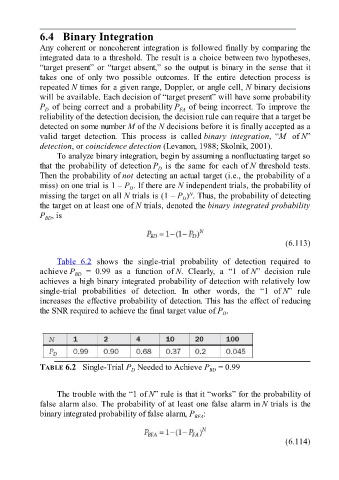Page 492 - Fundamentals of Radar Signal Processing
P. 492
6.4 Binary Integration
Any coherent or noncoherent integration is followed finally by comparing the
integrated data to a threshold. The result is a choice between two hypotheses,
“target present” or “target absent,” so the output is binary in the sense that it
takes one of only two possible outcomes. If the entire detection process is
repeated N times for a given range, Doppler, or angle cell, N binary decisions
will be available. Each decision of “target present” will have some probability
P of being correct and a probability P of being incorrect. To improve the
D
FA
reliability of the detection decision, the decision rule can require that a target be
detected on some number M of the N decisions before it is finally accepted as a
valid target detection. This process is called binary integration, “M of N”
detection, or coincidence detection (Levanon, 1988; Skolnik, 2001).
To analyze binary integration, begin by assuming a nonfluctuating target so
that the probability of detection P is the same for each of N threshold tests.
D
Then the probability of not detecting an actual target (i.e., the probability of a
miss) on one trial is 1 – P . If there are N independent trials, the probability of
D
N
missing the target on all N trials is (1 – P ) . Thus, the probability of detecting
D
the target on at least one of N trials, denoted the binary integrated probability
P , is
BD
(6.113)
Table 6.2 shows the single-trial probability of detection required to
achieve P = 0.99 as a function of N. Clearly, a “1 of N” decision rule
BD
achieves a high binary integrated probability of detection with relatively low
single-trial probabilities of detection. In other words, the “1 of N” rule
increases the effective probability of detection. This has the effect of reducing
the SNR required to achieve the final target value of P .
D
TABLE 6.2 Single-Trial P Needed to Achieve P = 0.99
BD
D
The trouble with the “1 of N” rule is that it “works” for the probability of
false alarm also. The probability of at least one false alarm in N trials is the
binary integrated probability of false alarm, P BFA :
(6.114)

